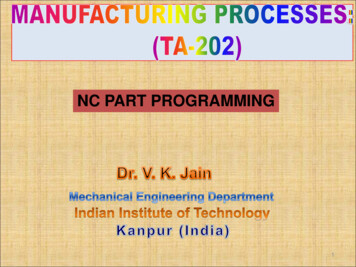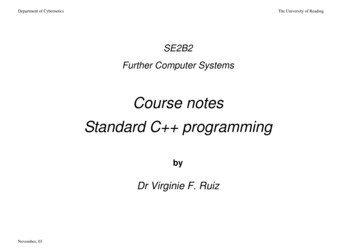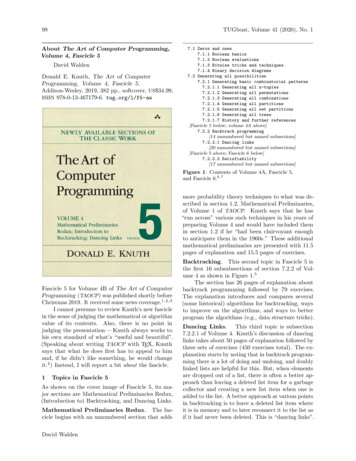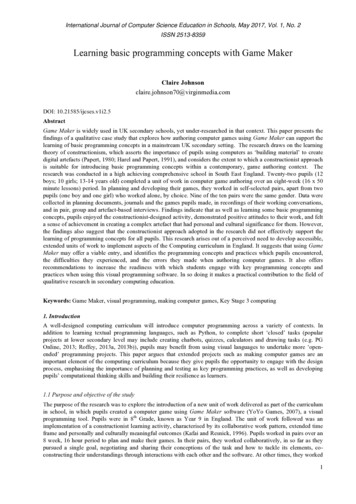
Transcription
Programming in Standard ML(D RAFT: V ERSION 1.2 OF 11.02.11.)Robert HarperCarnegie Mellon UniversitySpring Semester, 2011
Copyright c 2011 by Robert Harper.All Rights Reserved.This work is licensed under the Creative CommonsAttribution-Noncommercial-No Derivative Works 3.0 United StatesLicense. To view a copy of this license, 3.0/us/, or send aletter to Creative Commons, 171 Second Street, Suite 300, San Francisco,California, 94105, USA.
PrefaceThis book is an introduction to programming with the Standard ML programming language. It began life as a set of lecture notes for ComputerScience 15–212: Principles of Programming, the second semester of the introductory sequence in the undergraduate computer science curriculum atCarnegie Mellon University. It has subsequently been used in many othercourses at Carnegie Mellon, and at a number of universities around theworld. It is intended to supersede my Introduction to Standard ML, whichhas been widely circulated over the last ten years.Standard ML is a formally defined programming language. The Definition of Standard ML (Revised) is the formal definition of the language. Itis supplemented by the Standard ML Basis Library, which defines a common basis of types that are shared by all implementations of the language.Commentary on Standard ML discusses some of the decisions that went intothe design of the first version of the language.There are several implementations of Standard ML available for a widevariety of hardware and software platforms. The best-known compilersare Standard ML of New Jersey, MLton, Moscow ML, MLKit, and PolyML.These are all freely available on the worldwide web. Please refer to TheStandard ML Home Page for up-to-date information on Standard ML andits implementations.Numerous people have contributed directly and indirectly to this text.I am especially grateful to the following people for their helpful comments and suggestions: Brian Adkins, Nels Beckman, Marc Bezem, JamesBostock, Terrence Brannon, Franck van Breugel, Chris Capel, MatthewWilliam Cox, Karl Crary, Yaakov Eisenberg, Matt Elder, Mike Erdmann,Matthias Felleisen, Andrei Formiga, Stephen Harris, Nils Jähnig, Joel Jones,David Koppstein, John Lafferty, Johannes Laire, Flavio Lerda, Daniel R.Licata, Adrian Moos, Bryce Nichols, Michael Norrish, Arthur J. O’Dwyer,
Frank Pfenning, Chris Stone, Dave Swasey, Michael Velten, Johan Wallen,Scott Williams, and Jeannette Wing. Richard C. Cobbe helped with font selection. I am also grateful to the many students of 15-212 who used thesenotes and sent in their suggestions over the years.These notes are a work in progress. Corrections, comments and suggestions are most welcome.
ContentsPrefaceiiIOverview11Programming in Standard ML1.1 A Regular Expression Package . . . . . . . . . . . . . . . . .1.2 Sample Code . . . . . . . . . . . . . . . . . . . . . . . . . . . .II23The Core Language13Types, Values, and Effects2.1 Evaluation and Execution . .2.2 The ML Computation Model2.2.1 Type Checking . . . .2.2.2 Evaluation . . . . . . .2.3 Types, Types, Types . . . . . .2.4 Type Errors . . . . . . . . . . .2.5 Sample Code . . . . . . . . . .Declarations3.1 Variables . . . . . . . . .3.2 Basic Bindings . . . . . .3.2.1 Type Bindings . .3.2.2 Value Bindings .3.3 Compound Declarations3.4 Limiting Scope . . . . . .3312.1515161719212323.24242525262728
CONTENTS3.53.645678viTyping and Evaluation . . . . . . . . . . . . . . . . . . . . . . 29Sample Code . . . . . . . . . . . . . . . . . . . . . . . . . . . . 32Functions4.1 Functions as Templates . . . .4.2 Functions and Application . .4.3 Binding and Scope, Revisited4.4 Sample Code . . . . . . . . . .Products and Records5.1 Product Types . . . . . . . . . . . . . . . .5.1.1 Tuples . . . . . . . . . . . . . . . .5.1.2 Tuple Patterns . . . . . . . . . . . .5.2 Record Types . . . . . . . . . . . . . . . .5.3 Multiple Arguments and Multiple Results5.4 Sample Code . . . . . . . . . . . . . . . . .Case Analysis6.1 Homogeneous and Heterogeneous Types6.2 Clausal Function Expressions . . . . . . .6.3 Booleans and Conditionals, Revisited . .6.4 Exhaustiveness and Redundancy . . . . .6.5 Sample Code . . . . . . . . . . . . . . . . .Recursive Functions7.1 Self-Reference and Recursion7.2 Iteration . . . . . . . . . . . .7.3 Inductive Reasoning . . . . .7.4 Mutual Recursion . . . . . . .7.5 Sample Code . . . . . . . . . 6.Type Inference and Polymorphism8.1 Type Inference . . . . . . . . . .8.2 Polymorphic Definitions . . . .8.3 Overloading . . . . . . . . . . .8.4 Sample Code . . . . . . . . . . .67. 67. 70. 73. 76R EVISED 11.02.11D RAFTV ERSION 1.2
CONTENTS9viiProgramming with Lists779.1 List Primitives . . . . . . . . . . . . . . . . . . . . . . . . . . . 779.2 Computing With Lists . . . . . . . . . . . . . . . . . . . . . . 799.3 Sample Code . . . . . . . . . . . . . . . . . . . . . . . . . . . . 8110 Concrete Data Types10.1 Datatype Declarations . . . . .10.2 Non-Recursive Datatypes . . .10.3 Recursive Datatypes . . . . . .10.4 Heterogeneous Data Structures10.5 Abstract Syntax . . . . . . . . .10.6 Sample Code . . . . . . . . . . .8282838588899111 Higher-Order Functions11.1 Functions as Values .11.2 Binding and Scope .11.3 Returning Functions11.4 Patterns of Control .11.5 Staging . . . . . . . .11.6 Sample Code . . . . 6118119120122124.12 Exceptions12.1 Exceptions as Errors . . . . . . .12.1.1 Primitive Exceptions . . .12.1.2 User-Defined Exceptions .12.2 Exception Handlers . . . . . . . .12.3 Value-Carrying Exceptions . . . .12.4 Sample Code . . . . . . . . . . . .13 Mutable Storage13.1 Reference Cells . . . . . . . . . . . .13.2 Reference Patterns . . . . . . . . . .13.3 Identity . . . . . . . . . . . . . . . . .13.4 Aliasing . . . . . . . . . . . . . . . .13.5 Programming Well With References13.5.1 Private Storage . . . . . . . .13.5.2 Mutable Data Structures . . .13.6 Mutable Arrays . . . . . . . . . . . .R EVISED 11.02.11D RAFT.V ERSION 1.2
CONTENTSviii13.7 Sample Code . . . . . . . . . . . . . . . . . . . . . . . . . . . . 12614 Input/Output12714.1 Textual Input/Output . . . . . . . . . . . . . . . . . . . . . . 12714.2 Sample Code . . . . . . . . . . . . . . . . . . . . . . . . . . . . 12915 Lazy Data Structures15.1 Lazy Data Types . . . . . . .15.2 Lazy Function Definitions .15.3 Programming with Streams15.4 Sample Code . . . . . . . . .13013213313513716 Equality and Equality Types13816.1 Sample Code . . . . . . . . . . . . . . . . . . . . . . . . . . . . 13817 Concurrency13917.1 Sample Code . . . . . . . . . . . . . . . . . . . . . . . . . . . . 139IIIThe Module Language14018 Signatures and Structures18.1 Signatures . . . . . . . . . . . . .18.1.1 Basic Signatures . . . . . .18.1.2 Signature Inheritance . . .18.2 Structures . . . . . . . . . . . . .18.2.1 Basic Structures . . . . . .18.2.2 Long and Short Identifiers18.3 Sample Code . . . . . . . . . . . .19 Signature Matching19.1 Principal Signatures .19.2 Matching . . . . . . .19.3 Satisfaction . . . . . .19.4 Sample Code . . . . .142142143144147147148150.15115215315715720 Signature Ascription15820.1 Ascribed Structure Bindings . . . . . . . . . . . . . . . . . . . 15820.2 Opaque Ascription . . . . . . . . . . . . . . . . . . . . . . . . 159R EVISED 11.02.11D RAFTV ERSION 1.2
CONTENTSix20.3 Transparent Ascription . . . . . . . . . . . . . . . . . . . . . . 16220.4 Sample Code . . . . . . . . . . . . . . . . . . . . . . . . . . . . 16421 Module Hierarchies16521.1 Substructures . . . . . . . . . . . . . . . . . . . . . . . . . . . 16521.2 Sample Code . . . . . . . . . . . . . . . . . . . . . . . . . . . . 17322 Sharing Specifications17422.1 Combining Abstractions . . . . . . . . . . . . . . . . . . . . . 17422.2 Sample Code . . . . . . . . . . . . . . . . . . . . . . . . . . . . 18123 Parameterization23.1 Functor Bindings and Applications .23.2 Functors and Sharing Specifications23.3 Avoiding Sharing Specifications . . .23.4 Sample Code . . . . . . . . . . . . . .IV.Programming Techniques18218218518719119224 Specifications and Correctness24.1 Specifications . . . . . . . . . . . . . . . . . . . . . . . . . . .24.2 Correctness Proofs . . . . . . . . . . . . . . . . . . . . . . . .24.3 Enforcement and Compliance . . . . . . . . . . . . . . . . . .19419419619925 Induction and Recursion20225.1 Exponentiation . . . . . . . . . . . . . . . . . . . . . . . . . . 20225.2 The GCD Algorithm . . . . . . . . . . . . . . . . . . . . . . . 20725.3 Sample Code . . . . . . . . . . . . . . . . . . . . . . . . . . . . 21126 Structural Induction26.1 Natural Numbers . . . . . . . . .26.2 Lists . . . . . . . . . . . . . . . . .26.3 Trees . . . . . . . . . . . . . . . .26.4 Generalizations and Limitations26.5 Abstracting Induction . . . . . .26.6 Sample Code . . . . . . . . . . . .R EVISED 11.02.11D RAFT.212212214215216217219V ERSION 1.2
CONTENTSx27 Proof-Directed Debugging22027.1 Regular Expressions and Languages . . . . . . . . . . . . . . 22027.2 Specifying the Matcher . . . . . . . . . . . . . . . . . . . . . . 22227.3 Sample Code . . . . . . . . . . . . . . . . . . . . . . . . . . . . 22828 Persistent and Ephemeral Data Structures22928.1 Persistent Queues . . . . . . . . . . . . . . . . . . . . . . . . . 23228.2 Amortized Analysis . . . . . . . . . . . . . . . . . . . . . . . . 23528.3 Sample Code . . . . . . . . . . . . . . . . . . . . . . . . . . . . 23829 Options, Exceptions, and Continuations29.1 The n-Queens Problem . . . . . . . .29.2 Solution Using Options . . . . . . . .29.3 Solution Using Exceptions . . . . . .29.4 Solution Using Continuations . . . .29.5 Sample Code . . . . . . . . . . . . . .23923924124224424630 Higher-Order Functions30.1 Infinite Sequences . . . . . . . . . . . . .30.2 Circuit Simulation . . . . . . . . . . . . .30.3 Regular Expression Matching, Revisited30.4 Sample Code . . . . . . . . . . . . . . . .24724825125425631 Memoization31.1 Cacheing Results . . . . . .31.2 Laziness . . . . . . . . . . .31.3 Lazy Data Types in SML/NJ31.4 Recursive Suspensions . . .31.5 Sample Code . . . . . . . . .257257259261263264.265266266268272273.32 Data Abstraction32.1 Dictionaries . . . . . . . . . . . . . .32.2 Binary Search Trees . . . . . . . . . .32.3 Balanced Binary Search Trees . . . .32.4 Abstraction vs. Run-Time Checking32.5 Sample Code . . . . . . . . . . . . . .33 Representation Independence and ADT Correctness27433.1 Sample Code . . . . . . . . . . . . . . . . . . . . . . . . . . . . 274R EVISED 11.02.11D RAFTV ERSION 1.2
CONTENTSxi34 Modularity and Reuse27534.1 Sample Code . . . . . . . . . . . . . . . . . . . . . . . . . . . . 27535 Dynamic Typing and Dynamic Dispatch27635.1 Sample Code . . . . . . . . . . . . . . . . . . . . . . . . . . . . 27636 Concurrency27736.1 Sample Code . . . . . . . . . . . . . . . . . . . . . . . . . . . . 277VAppendices278A The Standard ML Basis Library279B Compilation Management280B.1 Overview of CM . . . . . . . . . . . . . . . . . . . . . . . . . . 281B.2 Building Systems with CM . . . . . . . . . . . . . . . . . . . . 281B.3 Sample Code . . . . . . . . . . . . . . . . . . . . . . . . . . . . 281C Sample ProgramsR EVISED 11.02.11282D RAFTV ERSION 1.2
Part IOverview
2Standard ML is a type-safe programming language that embodies manyinnovative ideas in programming language design. It is a statically typedlanguage, with an extensible type system. It supports polymorphic typeinference, which all but eliminates the burden of specifying types of variables and greatly facilitates code re-use. It provides efficient automaticstorage management for data structures and functions. It encourages functional (effect-free) programming where appropriate, but allows imperative (effect-ful) programming where necessary. It facilitates programmingwith recursive and symbolic data structures by supporting the definitionof functions by pattern matching. It features an extensible exception mechanism for handling error conditions and effecting non-local transfers ofcontrol. It provides a richly expressive and flexible module system forstructuring large programs, including mechanisms for enforcing abstraction, imposing hierarchical structure, and building generic modules. It isportable across platforms and implementations because it has a precisedefinition. It provides a portable standard basis library that defines a richcollection of commonly-used types and routines.Many implementations go beyond the standard to provide experimental language features, extensive libraries of commonly-used routines, anduseful program development tools. Details can be found with the documentation for your compiler, but here’s some of what you may expect.Most implementations provide an interactive system supporting on-lineprogram development, including tools for compiling, linking, and analyzing the behavior of programs. A few implementations are “batch compilers” that rely on the ambient operating system to manage the constructionof large programs from compiled parts. Nearly every compiler generatesnative machine code, even when used interactively, but some also generate code for a portable abstract machine. Most implementations support separate compilation and provide tools for managing large systemsand shared libraries. Some implementations provide tools for tracing andstepping programs; many provide tools for time and space profiling. Mostimplementations supplement the standard basis library with a rich collection of handy components such as dictionaries, hash tables, or interfaces tothe ambient operating system. Some implementations support languageextensions such as support for concurrent programming (using messagepassing or locking), richer forms of modularity constructs, and support for“lazy” data structures.R EVISED 11.02.11D RAFTV ERSION 1.2
Chapter 1Programming in Standard ML1.1A Regular Expression PackageTo develop a feel for the language and how it is used, let us consider theimplementation of a package for matching strings against regular expressions. We’ll structure the implementation into two modules, an implementation of regular expressions themselves and an implementation of amatching algorithm for them.These two modules are concisely described by the following signatures.signature REGEXP sigdatatype regexp Zero One Char of char Plus of regexp * regexp Times of regexp * regexp Star of regexpexception SyntaxError of stringval parse : string - regexpval format : regexp - stringendsignature MATCHER sigstructure RegExp : REGEXPval accepts : RegExp.regexp - string - boolendThe signature REGEXP describes a module that implements regular expressions. It consists of a description of the abstract syntax of regular expres-
1.1 A Regular Expression Package4sions, together with operations for parsing and unparsing them. The signature MATCHER describes a module that implements a matcher for a givennotion of regular expression. It contains a function accepts that, whengiven a regular expression, returns a function that determines whether ornot that expression accepts a given string. Obviously the matcher is dependent on the implementation of regular expressions. This is expressedby a structure specification that specifies a hierarchical dependence of an implementation of a matcher on an implementation of regular expressions —any implementation of the MATCHER signature must include an implementation of regular expressions as a constituent module. This ensures thatthe matcher is self-contained, and does not rely on implicit conventionsfor determining which implementation of regular expressions it employs.The definition of the abstract syntax of regular expressions in the signature REGEXP takes the form of a datatype declaration that is reminiscentof a context-free grammar, but which abstracts from matters of lexical presentation (such as precedences of operators, parenthesization, conventionsfor naming the operators, etc.) The abstract syntax consists of six clauses,corresponding to the regular expressions 0, 1, a, r1 r2 , r1 r2 , and r .1 Thefunctions parse and format specify the parser and unparser for regularexpressions. The parser takes a string as argument and yields a regularexpression; if the string is ill-formed, the parser raises the exception SyntaxError with an associated string describing the source of the error. Theunparser takes a regular expression and yields a string that parses to thatregular expression. In general there are many strings that parse to thesame regular expressions; the unparser generally tries to choose one thatis easiest to read.The implementation of the matcher consists of two modules: an implementation of regular expressions and an implementation of the matcheritself. An implementation of a signature is called a structure. The implementation of the matching package consists of two structures, one implementing the signature REGEXP, the other implementing MATCHER. Thus theoverall package is implemented by the following two structure declarations:structure RegExp : REGEXP .structure Matcher : MATCHER .The structure identifier RegExp is bound to an implementation of the REGEXP1 Someauthors use for 0 and ” for 1.R EVISED 11.02.11D RAFTV ERSION 1.2
1.1 A Regular Expression Package5signature. Conformance with the signature is ensured by the ascription ofthe signature REGEXP to the binding of RegExp using the “: ” notation.Not only does this check that the implementation (which has been elidedhere) conforms with the requirements of the signature REGEXP, but it alsoensures that subsequent code cannot rely on any properties of the implementation other than those explicitly specified in the signature. This helpsto ensure that modules are kept separate, facilitating subsequent changesto the code.Similarly, the structure identifier Matcher is bound to a structure thatimplements the matching algorithm in terms of the preceding implementation RegExp of REGEXP. The ascribed signature specifies that the structureMatcher must conform to the requirements of the signature MATCHER. Notice that the structure Matcher refers to the structure RegExp in its implementation.Once these structure declarations have been processed, we may use thepackage by referring to its components using paths, or long identifiers. Thefunction Matcher.match has typeMatcher.RegExp.regexp - string - bool,reflecting the fact that it takes a regular expression as implemented withinthe package itself and yields a matching function on strings. We may builda regular expression by applying the parser, Matcher.RegExp.parse, to astring representing a regular expression, then passing the resulting valueof type Matcher.RegExp.regexp to Matcher.accepts.2Here’s an example of the matcher in action:val regexp Matcher.RegExp.parse "(a b)*"val matches Matcher.accepts regexpval ex1 matches "aabba"(* yields true *)val ex2 matches "abac"(* yields false *)2 Itmight seem that one can apply Matcher.accepts to the output of RegExp.parse,since Matcher.RegExp.parse is just RegExp.parse. However, this relationship is notstated in the interface, so there is a pro forma distinction between the two. See Chapter 22for more information on the subtle issue of sharing.R EVISED 11.02.11D RAFTV ERSION 1.2
1.1 A Regular Expression Package6The use of long identifiers can get tedious at times. There are two typical methods for alleviating the burden. One is to introduce a synonym fora long package name. Here’s an example:structure M Matcherstructure R M.RegExpval regexp R.parse "((a %).(b %))*"val matches M.accepts regexpval ex1 matches "aabba"val ex2 matches "abac"Another is to “open” the structure, incorporating its bindings into the current environment:open Matcher Matcher.RegExpval regexp parse "(a b)*"val matches accepts regexpval ex1 matches "aabba"val ex2 matches "abac"It is advisable to be sparing in the use of open because it is often hard toanticipate exactly which bindings are incorporated into the environmentby its use.Now let’s look at the internals of the structures RegExp and Matcher.Here’s a bird’s eye view of RegExp:structure RegExp : REGEXP structdatatype regexp Zero One Char of char Plus of regexp * regexp Times of regexp * regexp Star of regexp.fun tokenize s .fun parse s letval (r, s’) R EVISED 11.02.11D RAFTV ERSION 1.2
1.1 A Regular Expression Package7parse rexp (tokenize (String.explode s))incase s’ ofnil r raise SyntaxError "Bad input."endhandle LexicalError raise SyntaxError "Bad input.".fun format r String.implode (format exp r)endThe elision indicates that portions of the code have been omitted so thatwe can get a high-level view of the structure of the implementation.The structure RegExp is bracketed by the keywords struct and end.The type regexp is implemented precisely as specified by the datatypedeclaration in the signature REGEXP. The parser is implemented by a function that, when given a string, “explodes” it into a list of characters, transforms the character list into a list of “tokens” (abstract symbols representing lexical atoms), and finally parses the resulting list of tokens to obtainits abstract syntax. If there is remaining input after the parse, or if thetokenizer encountered an illegal token, an appropriate syntax error is signalled. The formatter is implemented by a function that, when given apiece of abstract syntax, formats it into a list of characters that are then“imploded” to form a string. The parser and formatter work with character lists, rather than strings, because it is easier to process lists incrementally than it is to process strings.It is interesting to consider in more detail the structure of the parsersince it exemplifies well the use of pattern matching to define functions.Let’s start with the tokenizer, which we present here in toto:datatype token AtSign Percent Literal of char PlusSign TimesSign Asterisk LParen RParenexception LexicalErrorfun tokenize nil nilR EVISED 11.02.11D RAFTV ERSION 1.2
1.1 A Regular Expression Package8 tokenize (#" " :: cs) PlusSign :: tokenize cstokenize (#"." :: cs) TimesSign :: tokenize cstokenize (#"*" :: cs) Asterisk :: tokenize cstokenize (#"(" :: cs) LParen :: tokenize cstokenize (#")" :: cs) RParen :: tokenize cstokenize (#"@" :: cs) AtSign :: tokenize cstokenize (#"%" :: cs) Percent :: tokenize cstokenize (#"\\" :: c :: cs) Literal c :: tokenize cs tokenize (#"\\" :: nil) raise LexicalError tokenize (#" " :: cs) tokenize cs tokenize (c :: cs) Literal c :: tokenize csThe symbol “@” stands for the empty regular expression and the symbol“%” stands for the regular expression accepting only the null string. Concatentation is indicated by “.”, alternation by “ ”, and iteration by “*”.We use a datatype declaration to introduce the type of tokens corresponding to the symbols of the input language. The function tokenizehas type char list - token list; it transforms a list of characters intoa list of tokens. It is defined by a series of clauses that dispatch on the firstcharacter of the list of characters given as input, yielding a list of tokens.The correspondence between characters and tokens is relatively straightforward, the only non-trivial case being to admit the use of a backslashto “quote” a reserved symbol as a character of input. (More sophisticatedlanguages have more sophisticated token structures; for example, words(consecutive sequences of letters) are often regarded as a single token ofinput.) Notice that it is quite natural to “look ahead” in the input streamin the case of the backslash character, using a pattern that dispatches onthe first two characters (if there are such) of the input, and proceeding accordingly. (It is a lexical error to have a backslash at the end of the input.)Let’s turn to the parser. It is a simple recursive-descent parser implementing the precedence conventions for regular expressions given earlier.These conventions may be formally specified by the following grammar,which not only enforces precedence conventions, but also allows for theR EVISED 11.02.11D RAFTV ERSION 1.2
1.1 A Regular Expression Package9use of parenthesization to override them.rexprtrmrfacratm:: :: :: :: rtrm rtrm rexprfac rfac.rtrmratm ratm*@ % a (rexp)The implementation of the parser follows this grammar quite closely.It consists of four mutually recursive functions, parse rexp, parse rtrm,parse rfac, and parse ratm. These implement what is known as a recursive descent parser that dispatches on the head of the token list to determinehow to proceed.fun parse rexp ts letval (r, ts’) parse rtrm tsincase ts’of (PlusSign :: ts’’) letval (r’, ts’’’) parse rexp ts’’in(Plus (r, r’), ts’’’)end (r, ts’)endand parse rtrm ts .and parse rfac ts letval (r, ts’) parse ratm tsincase ts’of (Asterisk :: ts’’) (Star r, ts’’) (r, ts’)endand parse ratm nil raise SyntaxError ("No atom") parse ratm (AtSign :: ts) (Zero, ts) parse ratm (Percent :: ts) (One, ts)R EVISED 11.02.11D RAFTV ERSION 1.2
1.1 A Regular Expression Package10 parse ratm ((Literal c) :: ts) (Char c, ts) parse ratm (LParen :: ts) letval (r, ts’) parse rexp tsincase ts’of (RParen :: ts’’) (r, ts’’) raise SyntaxError "No close paren"endNotice that it is quite simple to implement “lookahead” using patterns thatinspect the token list for specified tokens. This parser makes no attemptto recover from syntax errors, but one could imagine doing so, using standard techniques.This completes the implementation of regular expressions. Now for thematcher. The matcher proceeds by a recursive analysis of the regular expression. The main difficulty is to account for concatenation — to match astring against the regular expression r1 r2 we must match some initial segment against r1 , then match the corresponding final segment against r2 .This suggests that we generalize the matcher to one that checks whethersome initial segment of a string matches a given regular expression, thenpasses the remaining final segment to a continuation, a function that determines what to do after the initial segment has been successfully matched.This facilitates implementation of concatentation, but how do we ensurethat at the outermost call the entire string has been matched? We achievethis by using an initial continuation that checks whether the final segmentis empty.Here’s the code, written as a structure implementing the signature MATCHER:structure Matcher : MATCHER structstructure RegExp RegExpopen RegExpfun match Zero k false match One cs k k cs match (Char c) cs k (case cs of nil false c’::cs’ (c c’) andalso (k cs’ ))R EVISED 11.02.11D RAFTV ERSION 1.2
1.1 A Regular Expression Package11 match (Plus (r1, r2)) cs k match r1 cs k orelse match r2 cs k match (Times (r1, r2)) cs k match r1 cs (fn cs’ match r2 cs’ k) match (Star r) cs k letval mstar cs’ k cs’ orelse match r cs’ mstarinmstar csendfun accepts regexp string match regexp (String.explode string) (fn nil true end false)Note that we incorporate the structure RegExp into the structure Matcher,in accordance with the requirements of the signature. The function acceptsexplodes the string into a list of characters (to facilitiate sequential processing of the input), then calls match with an initial continuation that ensuresthat the remaining input is empty to determine the result. The type ofmatch isRegExp.regexp - char list - (char list - bool) - bool.That is, match takes in succession a regular expression, a list of characters,and a continuation of type char list - bool; it yields as result a valueof type bool. This is a fairly complicated type, but notice that nowhere didwe have to write this type in the code! The type inference mechanism ofML took care of determining what that type must be based on an analysisof the code itself.Since match takes a function as argument, it is said to be a higher-orderfunction. The simplicity of the matcher is due in large measure to the
variety of hardware and software platforms. The best-known compilers are Standard ML of New Jersey, MLton, Moscow ML, MLKit, and PolyML. These are all freely available on the worldwide web. Please refer to The Standard ML Home Page for up-to











